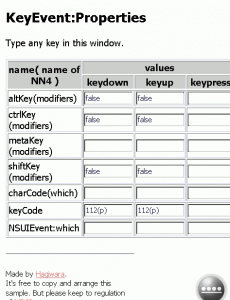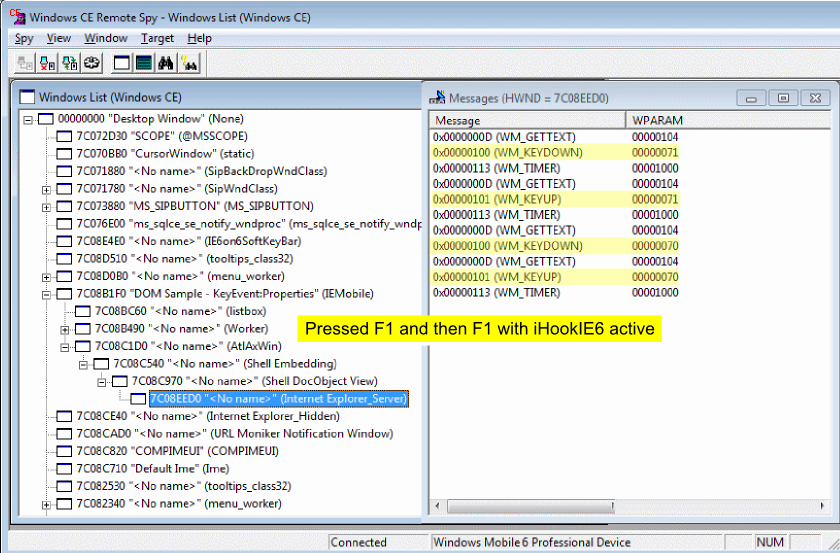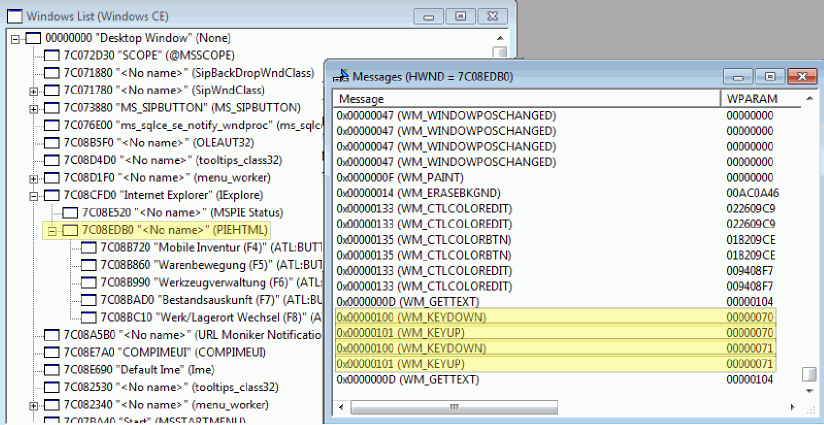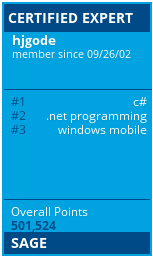Windows Mobile: redirect function keys into Internet Explorer Mobile browser
iHookIE6
this small tool enables you to use Function keys within Internet Explorer Mobile (IEM) web sites.
Normally, most function keys are catched and used by the OS (GWES) to perfom special actions like menu softkeys, phone call, end phone, volume up, volume down and more.
Using a keyboard hook we can catch the function key presses, or better say WM_KEYDOWN and WM_KEYUP messages before the OS can catch them.
One challenge was to find the window that processes normal key presses. The keyboard windows messages are not send to the top level window. Using the Remote Spy Tool I found the Window inside Internet Explorer window that finally processes keyboard messages. Now the tool can hook the keyboard, catch F key presses (F1 to F24) and send them directly to the browser window (class name = “Internet Explorer_Server”). The tool simply uses FindWindow and GetWindow to locate the window handle of this window and then does a PostMessage with WM_KEYDOWN and WM_KEYUP directly to the browser window.
The hook function:
__declspec(dllexport) LRESULT CALLBACK g_LLKeyboardHookCallback(
int nCode, // The hook code
WPARAM wParam, // The window message (WM_KEYUP, WM_KEYDOWN, etc.)
LPARAM lParam // A pointer to a struct with information about the pressed key
)
{
static int iActOn = HC_ACTION;
bool processed_key=false;
int iResult=0;
if (nCode == iActOn)
{
HWND hwndBrowserComponent=getIEMBrowserWindow(); //get the browser window
if(getIEMWindow(&iResult)==NULL || hwndBrowserComponent==NULL) // if IE is not loaded or not in foreground or browser window not found
return CallNextHookEx(g_hInstalledLLKBDhook, nCode, wParam, lParam);
PKBDLLHOOKSTRUCT pkbhData = (PKBDLLHOOKSTRUCT)lParam;
//we are only interested in FKey press/release
if(pkbhData->vkCode >= VK_F1 && pkbhData->vkCode <=VK_F24){
DEBUGMSG(1,(L"found function key 0x%08x ...\n", pkbhData->vkCode));
if(processed_key==false){
if (wParam == WM_KEYUP)
{
//synthesize a WM_KEYUP
DEBUGMSG(1,(L"posting WM_KEYUP 0x%08x to 0x%08x, lParam=0x%08x...\n", pkbhData->vkCode, hwndBrowserComponent, g_lparamCodeUp[pkbhData->vkCode - 0x70]));
PostMessage(hwndBrowserComponent, WM_KEYUP, pkbhData->vkCode, g_lparamCodeUp[pkbhData->vkCode - 0x70]);
processed_key=true;
}
else if (wParam == WM_KEYDOWN)
{
//synthesize a WM_KEYDOWN
DEBUGMSG(1,(L"posting WM_KEYDOWN 0x%08x to 0x%08x, lParam=0x%08x...\n", pkbhData->vkCode, hwndBrowserComponent, g_lparamCodeDown[pkbhData->vkCode - 0x70]));
PostMessage(hwndBrowserComponent, WM_KEYDOWN, pkbhData->vkCode, g_lparamCodeDown[pkbhData->vkCode - 0x70]);
processed_key=true;
}
}
}
}
else
DEBUGMSG(1, (L"Got unknwon action code: 0x%08x\n", nCode));
//shall we forward processed keys?
if (processed_key)
{
processed_key=false; //reset flag
if (bForwardKey){
return CallNextHookEx(g_hInstalledLLKBDhook, nCode, wParam, lParam);
}
else
return true;
}
else
return CallNextHookEx(g_hInstalledLLKBDhook, nCode, wParam, lParam);
}
You will see, that the web site code in IEM can now process these function key presses using the body onKeyDown event.
the browser window with a javascript key demo:

(see also onkey.htm in http://www.hjgode.de/wp/2009/05/14/internet-explorer-mobile-handles-key-events/)
The same will not work, if you switched the browser engine from IE6 (or MSHTML) to PocketIE using the HKLM\Security\Internet Explorer\MSHTML=”0″ entry.
Screenshot shows that function keys are sent to the browser window. But you will see no reaction inside the web site.
Only the newer engine, started with Windows Mobile AKU 6.1.4, supports keyboard events inside the javascript object model.
To find the browser window, you normally would use EnumChildWindows(), but this API is not available on Windows CE based devices. So I re-used some code to scan a window for child and sibling windows to find the nested browser window:
//search for a child window with class name
static BOOL bStopScan=FALSE;
BOOL scanWindow(HWND hWndStart, TCHAR* szClass){
HWND hWnd = NULL;
HWND hWnd1 = NULL;
hWnd = hWndStart;
TCHAR cszWindowString [MAX_PATH]; // = new TCHAR(MAX_PATH);
TCHAR cszClassString [MAX_PATH]; //= new TCHAR(MAX_PATH);
TCHAR cszTemp [MAX_PATH]; //= new TCHAR(MAX_PATH);
BOOL bRet=FALSE;
while (hWnd!=NULL && !bStopScan){
//do some formatting
GetClassName(hWnd, cszClassString, MAX_PATH);
GetWindowText(hWnd, cszWindowString, MAX_PATH);
wsprintf(cszTemp, L"\"%s\" \"%s\"\t0x%08x\n", cszClassString, cszWindowString, hWnd);//buf);
//DEBUGMSG(1, (cszTemp));
if(wcsicmp(cszClassString, szClass)==0){
DEBUGMSG(1 , (L"\n################### found target window, hwnd=0x%08x\n\n", hWnd));
//set global hwnd
g_hWndIEM6=hWnd; //store in global var
hWnd=NULL;
hWndStart=NULL;
bRet=TRUE;
bStopScan=TRUE;
return TRUE; //exit loop
}
// Find next child Window
hWnd1 = GetWindow(hWnd, GW_CHILD);
if( hWnd1 != NULL ){
scanWindow(hWnd1, szClass);
}
hWnd=GetWindow(hWnd,GW_HWNDNEXT); // Get Next Window
}
return bRet;
}
Thanks to all the code providers in the internet. Keep coding and publishing.






 http://www.led-mg.de
http://www.led-mg.de